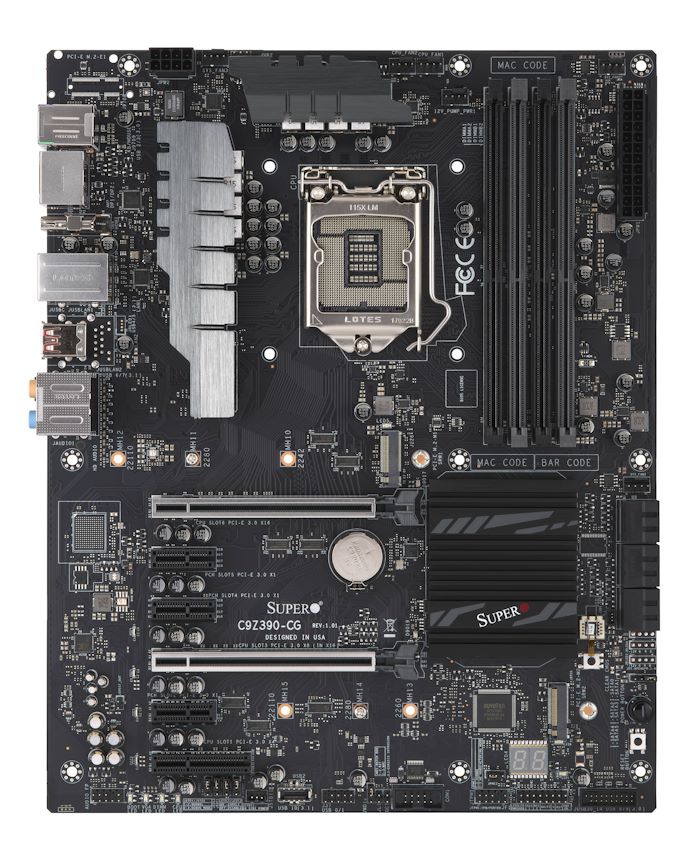Intel Z390 Motherboard Overview: 50+ Motherboards Analyzed
by Ian Cutress & Gavin Bonshor on October 8, 2018 10:53 AM EST- Posted in
- Motherboards
- Intel
- MSI
- Gigabyte
- ASRock
- EVGA
- Asus
- NZXT
- Supermicro
- Z390
Supermicro C9Z390-CG
The Supermicro C9Z390-CG and the more expensive C9Z390-CGW seemingly have the same PCB layout which could indicate that both PCB boards are identical in terms of specification, but with this model having less in the way of controllers etc. Aesthetically the CG drops the use of a rear panel cover with metallic grey power delivery heatsinks and a black/grey chipset heatsink. The other key difference is that the C9Z390-CG completely drops RGB support with no integrated LEDs or headers onboard at all. On the storage side of things, the C9Z390-CG has two PCIe 3.0 x4 M.2 slots and also includes a total of six SATA ports.
The C9Z390-CG has a total of four RAM slots with support for DDR4-3866 and up to 64 GB in total. On the PCIe front, the board has two full-length PCIe 3.0 slots which operate at ether x16/x4 with the bottom PCIe 3.0 x4 slot populated at the bottom and/or x16/x8 and the bottom slot is disabled when the second full-slot is in use. Separate to the these is a total of three PCIe 3.0 x1 slots.
Compared to the more feature-rich and more expensive C9Z390-CGW (on the previous page), the C9Z390-CG has the same layout minus one of the dual LAN and instead opts for a single Intel I219V Gigabit LAN. The USB ports included on the rear panel consist of three USB 3.1 Gen2 Type-A, one USB 3.1 Gen2 Type-C and two USB 3.0 Type-A ports. The onboard audio which consists of five 3.5 mm audio jacks and an optical S/PDIF output is controlled by a Realtek ALC1220 HD audio codec and the C9Z390-CG also has a trio of video outputs with two DisplayPort 1.2 and a single HDMI 1.4 port.
The Supermicro C9Z390-CG pricing as it stands is currently unavailable. The target market is gamers on a budget and offers a more cost-effective and solid feature set without passing the cost of flashy RGB and unnessacary visually pleasing covers with the primary focus being on the performance.












79 Comments
View All Comments
pawinda8 - Monday, October 15, 2018 - link
Still no mention of any Z390 boards with native Thunderbolt 3 (not AIC)! Has Intel given up on Thunderbolt for the PC world?gavbon - Monday, October 15, 2018 - link
If it's not integrated into the chipset, it's not really native as such. The ASRock Z390 Phantom Gaming-ITX/ac has a Thunderbolt 3 port on the rear panel, but that's the only one I'm afraidHikariWS - Monday, October 15, 2018 - link
Oculus Rift requires 3 USB3 ports and doesn't accept any of them being connected to a hub, they all need to be connected directly into a raw port. I had to buy a dedicated 3GIO USB 3 board that added 6 useful extra ports. In my (yes, old) Gigabyte z87 mobo I also had issues using keyboard and mouse on USB 3 ports inside UEFI and some recovery softwares, so I had to buy a USB 2 mirror to connect them.Because of that, having USB 2 ports on front panel and nice quantity of USB 3 is what most differs mobos for me, given that all other features are nearly the same.
ASUS Z390-A seems to be the best option. It has the important double USB2 ports, 5 USB3 ports and still has HDMI and DP for emergencies.
just4U - Monday, October 15, 2018 - link
I wish MSI had released a "godlike" board for the Ryzen series.ThugEsquire - Tuesday, October 16, 2018 - link
You list the ASRock Z390 Phantom Gaming-ITX/ac above as an ATX board, but it's actually mITX. FYIgavbon - Friday, October 19, 2018 - link
I have gone through every page where the Phantom Gaming-ITX/ac is listed, but I can't see where it says it's an ATX board? Could you please be more specific? Are you viewing on mobile or desktop?Galcobar - Tuesday, October 16, 2018 - link
It would be really helpful to break out one more criteria into a table: Type-C header for case-front ports.Helping a friend put together an i5 system and, knowing he'll keep it for a long time, am trying to get even with peripheral connectors (already has a monitor, so no using that as a hub). It's relatively easy to identify cases with a Type-C port, but that's pointless without a motherboard header. Having to go into each board's page to check is time-consuming.
jjnam - Thursday, April 18, 2019 - link
6 months later and I'm here for EXACTLY this reason. I've gone through probably 50 manuals over the past few days squinting to find this information. What a pain.Synomenon - Thursday, October 18, 2018 - link
So on the ASRock Z390 Phantom Gaming-ITX/ac, is the TB3 port on the rear using up lanes from CPU (making the only 16x slot, 8x only)?If it's not using lanes from the CPU, how will using that TB3 port (say with a USB3.1 Gen2 hub OR TB3 hub) affect all the other ports / IO on the board?
repoman27 - Thursday, October 18, 2018 - link
Going off of what TweakTown published, it's a single-port Intel JHL6240 "Alpine Ridge" controller with a PCI 3.0 x2 connection to the PCH. So it won't affect the PEG lanes from the CPU. I'm amazed it's not Titan Ridge at this point though.